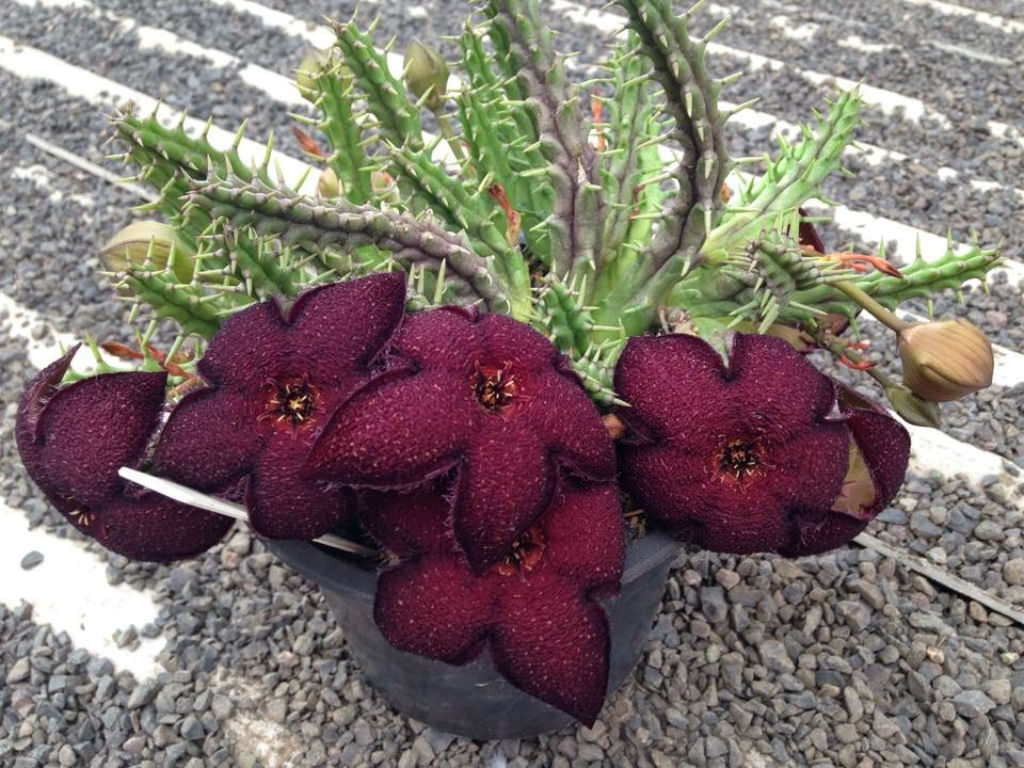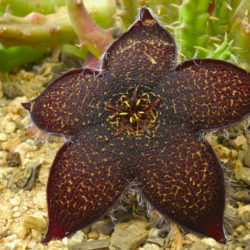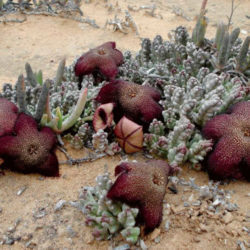Scientific Name
Tridentea gemmiflora (Masson) Haw.
Common Name(s)
Black Carrion Flower, Twin-flowered Tridentea
Synonym(s)
Ceropegia gemmiflora, Stapelia gemmifera, Stapelia gemmiflora, Stisseria gemmiflora
Scientific Classification
Family: Apocynaceae
Subfamily: Asclepiadoideae
Genus: Tridentea
Description
Tridentea gemmiflora is a small succulent that forms dense clumps of erect stems with four angles lined with tubercles ending in long, finely-pointed rudimentary leaves. The stems are fleshy, greyish-green, growing up to 6 inches (15 cm) tall and 0.6 inches (1.5 cm) thick. The leaves are up to 4 inches (1 cm) long.
In fall, the plant produces inflorescences with 1 to 4 flowers developing successively on an up to 0.8 inches (2 cm) long stalk near the base of the stems. Each flower is attached to the inflorescence with an up to 2 inches (5 cm) long stalk. The corolla is up to 4 inches (10 cm) in diameter, inside brown to purple-black, irregularly mottled with yellowish, and has five spreading lobes with marginal cilia. The corona is yellow, heavily marked with dark purple.
Origin
Tridentea gemmiflora is native to South Africa. It grows in red sandy soil in Western Cape, Northern Cape, Eastern Cape, Free State, and North West provinces.

Hardiness
USDA hardiness zone 9a to 11b: from 25 °F (−3.9 °C) to 50 °F (+10 °C).
How to Grow and Care
Stapeliads are relatively easy to grow. However, they should be treated as an outdoor plants as they will easily rot indoors and cannot flower without exposure to outdoor temperature fluctuations. They should be grown under cover so that watering can be controlled. They require a reasonable amount of sunlight to promote flowering and maintain a well-shaped plant. Very shady positions will produce very poor flowering. Stapeliads come from climates that survive extremely high temperatures in the summer months, so most growth is in spring and autumn, with flowering in autumn when the weather cools down. Water in moderation when needed in the growing season, ensuring the soil is fairly dried out between waterings. Do not water between November 1 and March 1.
The easiest and best way to propagate Stapeliads is from stem cuttings, which can be taken virtually throughout the year. Using seeds is also a method of propagation.
See more at How to Grow and Care for Stapeliads.
Links
- Back to genus Tridentea
- Succupedia: Browse succulents by Scientific Name, Common Name, Genus, Family, USDA Hardiness Zone, Origin, or cacti by Genus
Photo Gallery
Click on a photo to see a larger version.

